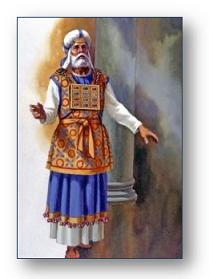The High-Priest: His Consecration and Duties His Consecration and Duties
The High-Priest: His Consecration and Duties His Consecration and Duties
Today there are some groups of people who believe that we should do away with the Old Testament and use the New Testament only. Those who hold this belief deprive themselves of many beautiful types of Christ and His work pictured so clearly in the Old Testament. The ceremonial laws of washings and cleansings, the sacrifices, the feast days, the tabernacle and its furniture, and the priesthood are all signs and types of Christ. They present to our mind, and if God may apply it, to our heart, a clearer picture of the person and work of that Saviour who now has come and fulfilled that mediatorial work which the ceremonial law so clearly showed was necessary. Christ Himself answered the Jews saying, "Search the scriptures; (which was only the Old Testament at that time) for in them ye think ye have eternal life: and they are they which testify of me." May this be our purpose, also, when we study together about the High Priest.
The word priest comes from a Hebrew root word meaning "to draw near". The main purpose of the Old Testament Priesthood teaches us a lesson largely ignored or passed over by many today. The children of Israel, as sinners, could not approach unto such a Holy God of themselves. They needed a mediator: one who could go in between to reconcile them with God. They needed a priest; One who could "draw near" to that infinitely Holy One.
In studying what the Word of God teaches us about the High Priest let us briefly examine the consecration, the duties, the regulations, and the clothing of the High Priest. Each of these aspects will point us to the necessity of a mediator between a Holy God and a sinful people; but more, they will also point us to who that mediator is. The history of the High Priest directs us "to that one Name given under Heaven whereby we must be saved"; to that eternal prophet, priest, and king — the Lord Jesus Christ.
The Consecration of the High Priest⤒🔗
The consecration of a High-Priest to his office took place in a very special service, (Exodus 29).
- A ram, without blemish, was killed and burned entirely as a burnt offering unto the Lord. This points to the total dedication of the High Priest to God. The whole ram had to be offered, as Christ offered His whole Life.
- The blood of the ram was caught, and put on the tip of the right ear, the thumb of the right hand, and on the large toe of the right foot of the High Priest. This speaks of a life of separation from sin; a life of holiness in all aspects, as Christ alone lived during his entire life.
- The remaining blood was poured on the altar; then collected again from the altar, mixed with the anointing oil, and sprinkled upon the High Priest and his garments. This signified a complete separation and calling to God's service. It pointed to Christ alone, Who was anointed and lived a completely dedicated life to His Father — fulfilling perfectly the will of His Father in all things.
- The priests had to take part of the ram, a loaf of bread, a cake of oiled bread, one wafer, and put them in the hands of the High Priest who would wave them for a wave offering before the Lord. This reveals the preciousness of the work of Christ not only to a sinner, but also the preciousness of His work before God. God the Father is fully satisfied when viewing the finished work of His Son, it is a wave offering before Him. This service was conducted seven days in a row to show its Divine completeness.
The Duties of the High Priest←⤒🔗
After this consecration ceremony the High Priest began his duties which were especially these five: (Notice how each one teaches something of the work of the Lord Jesus)
- The High Priest presented the sin offering for the nation as occasion required. It speaks of the Lord Jesus presenting Himself as a sin offering for the sins of His people. (Lev. 4)
- The High Priest performed the atoning sacrifice and burnt offering on the great Day of Atonement once a year, entering the Holy of Holies with the blood from the sacrifice. So Christ gave Himself as that whole burnt offering to atone for His people on the Cross; the fulfillment of the great Day of Atonement. He also has entered into the presence of His Father to present His work before His Father, for His people, as we may read in Hebrews 9:24 "For Christ is not entered into the Holy places made with hands, which are the figures of the true; but into heaven itself, to appear in the presence of God for us."
- The High Priest used the Urim and the Thummim to inform the people of the will of the Lord in matters concerning their nation. So the Lord Jesus teaches His people and reveals to them His will, concerning how they should walk before Him.
- The High Priest was an important civil ruler as well as a spiritual head for the nation. This testifies of the Lord Jesus, Who is King of His church to govern and protect them as well as Priest to intercede and atone for them.
- The High Priest supervised the rest of the priests and the entire tabernacle or temple worship. So, also, Christ; as the Great High Priest, walks in the midst of the Golden Candlesticks, (Rev. 1), ministers at the Golden Altar (Rev. 8:34), feeds His people with living bread (John 6:51), presents his own sacrifice to God, and directs the entire ministry of His Church (Eph. 4:8-16).
Regulations Governing the High Priest←⤒🔗
 Aaron was the first High Priest; his name means "very high". His name is a type of the Greater High Priest, of whom John the Baptist testified "He it is, who coming after me is preferred before me, whose shoe latchet I am not worthy to unloose." Strict regulations were placed upon Aaron and the following High Priests, to keep their office "very high". The High Priest was not allowed to marry anyone except an Israelite virgin, not even a widow of his own people; he could not attend any funeral or touch a dead body, not even from his own family; he could not defile his person in any way to profane the sanctuary of the Lord. These strict regulations teach us of the necessity of the mediator being sinless, being perfect; for God is too holy to overlook sin. Therefore it was necessary for Christ to be both God and man: God to live perfectly holy, to give an infinite value to His work, and to bear the full wrath of God against sin; and man so He could suffer and die; because it was man that had sinned, God's justice required that man had to pay the penalty of that sin. Christ, though tempted severely, lived a perfectly holy life, never sinning in thought, word or deed, so not as the former High Priests who had to atone for their own sins and the peoples each day, but now we read of Him that "by one offering He hath perfected for ever them that are sanctified".
Aaron was the first High Priest; his name means "very high". His name is a type of the Greater High Priest, of whom John the Baptist testified "He it is, who coming after me is preferred before me, whose shoe latchet I am not worthy to unloose." Strict regulations were placed upon Aaron and the following High Priests, to keep their office "very high". The High Priest was not allowed to marry anyone except an Israelite virgin, not even a widow of his own people; he could not attend any funeral or touch a dead body, not even from his own family; he could not defile his person in any way to profane the sanctuary of the Lord. These strict regulations teach us of the necessity of the mediator being sinless, being perfect; for God is too holy to overlook sin. Therefore it was necessary for Christ to be both God and man: God to live perfectly holy, to give an infinite value to His work, and to bear the full wrath of God against sin; and man so He could suffer and die; because it was man that had sinned, God's justice required that man had to pay the penalty of that sin. Christ, though tempted severely, lived a perfectly holy life, never sinning in thought, word or deed, so not as the former High Priests who had to atone for their own sins and the peoples each day, but now we read of Him that "by one offering He hath perfected for ever them that are sanctified".

Add new comment